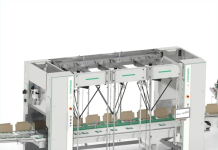In the recent past, Ravi Graphics has been expanding its footprint in the packaging printing space. The investment in the Easymatrix 106 CS was another attempt to strengthen the packaging set up.
Bengaluru-based Ravi Graphics has installed a brand new Easymatrix 106 CS diecutter at its second plant. The machine was installed at the company shop floor in the first quarter of the calendar year of 2021.
“We did an in-depth study of all the solutions in the market. We realized that Easymatrix 106 CS is the most silent machine among all the options available in the market. Also, the machine is really great when it comes to quality. And the fact that it has a GS certificate is a big plus,” says V R Sharath of Ravi Graphics.
The Easymatrix 106 has an output of 7,700 sheets per hour. It processes materials from 90 to 2,000 g/m². Even corrugated boards up to 4 mm thickness can be processed. The Easymatrix 106 is available as a C version or CS version. The C version features a diecutting station, while the CS version comes equipped with an additional stripping station. The stripping station allows for mechanical removal of internal waste, lateral edges, and the rear edge of the sheet. This reduces downstream manual work to a minimum or even eliminates it completely.
Easymatrix’s other features include non-stop rake delivery for uninterrupted production during pile changes and a Quick-Lock system to increase the speed and accuracy of the diecutting process. The Quick-Lock system ensures rapid and precise positioning of tools on the stripping frame, eliminating time-consuming, manual repositioning of tools for each production run.
The GS certificate verifies that the Easymatrix 106 C/CS underwent rigorous testing and thus meets the strict safety standards of the German professional association ETEM (Energie Textil Elektro Medienerzeugnisse).
Ravi Graphics offers both commercial book and packaging printing services, with packaging having about 20% share in the overall business. In the packaging division, the company prints and converts monocartons and corrugated boxes. The vertical packaging converts about 100 tons of paper and paperboard every month.
Ravi Graphics increasing focus on packaging
In the recent past, Ravi Graphics has been expanding its footprint in the packaging printing space. The investment in the Easymatrix 106 CS was another attempt to strengthen the packaging setup.
“We are moving more and more into packaging now. So, keeping that in mind we thought that a machine like Easymatrix 106 CS would boost our capabilities, especially in the converting department. Even though the machine commands a premium compared to its peers, I feel this has been a very good buy,” adds V R Bharath of Ravi Graphics.
Ravi Graphics has an elaborate set of machinery at its two plants. It has two Heidelberg SM 74 presses, an SM 102 four-color press, a Marland press, and a Mitsubishi press. In addition to the Easymatrix 106, Ravi Graphics has a whole host of other finishing equipment. One unit is dedicated to commercial print operations, while the second unit is for packaging operations.
Path to recovery
Like many other printers in the country, Ravi Graphics, too, has been impacted by the Covid-19 pandemic and the resultant lockdowns. Its commercial printing operations have been badly hit while the packaging division has been pretty steady. According to Sharath, the overall business of the company is on the path to recovery.
“We have managed to get back to 70% of our pre-pandemic volumes. Commercial printing has seen a bigger hit compared to the packaging printing operations. However, we have managed to hold our own during the last one and half years. We see a steady recovery in the business and hope to get back to normalcy by the end of the 2021-22 financial year if there is no third wave,” he says.
Talking about further investments, Sharath says that the company plans to further add to the converting section.
“Our printing section is pretty solid at the moment and we are more or less satisfied with our capabilities. However, over the next one to two years, our focus will be to boost our capabilities in the converting sections,” Sharath concludes.










